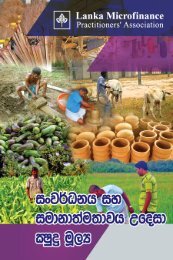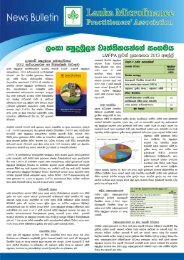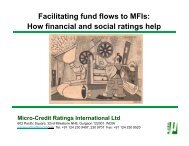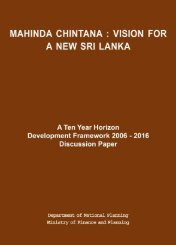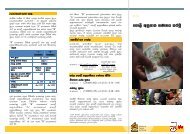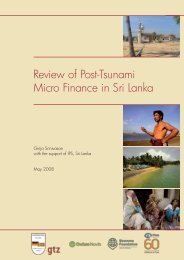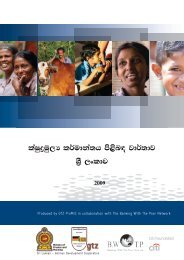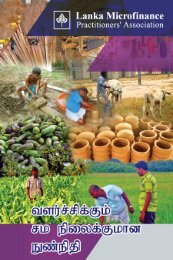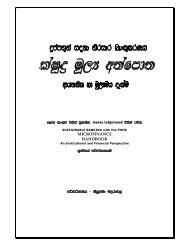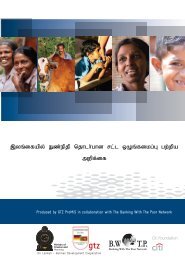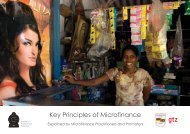National Microfinance Study of Sri Lanka: Survey of Practices and ...
National Microfinance Study of Sri Lanka: Survey of Practices and ...
National Microfinance Study of Sri Lanka: Survey of Practices and ...
You also want an ePaper? Increase the reach of your titles
YUMPU automatically turns print PDFs into web optimized ePapers that Google loves.
Sewa <strong>Lanka</strong><br />
Sewa <strong>Lanka</strong> works in Anuradhapura, Vavuniya <strong>and</strong> Trincomalee <strong>and</strong> operates at<br />
least 86 ‘Sewa Societies’ in Vavuniya. Detailed information on savings <strong>and</strong> loan<br />
activities was not forthcoming for the study. However, it is known that in the<br />
Sewa Societies current savings amount to approximately SLR 3,000,000 <strong>and</strong> loan<br />
funds are approximately SLR 8,400,000. It is also known that Sewa <strong>Lanka</strong> has<br />
borrowed up to SLR 20 million in funds from the NDTF in addition to donor<br />
funds from AusAID, DRC, UNHCR <strong>and</strong> UNICEF. There appears to be a<br />
disparity between inputs <strong>and</strong> outputs <strong>and</strong> the organisation should be evaluated <strong>and</strong><br />
an impact assessment undertaken.<br />
South Asia Partnership <strong>Sri</strong> <strong>Lanka</strong><br />
SAPSRI was established initially with Canadian Funds <strong>and</strong> is today an NGO that<br />
operates as a not for pr<strong>of</strong>it company. SAPSRI has undertaken micr<strong>of</strong>inance<br />
schemes since 1989 <strong>and</strong> primarily targets small very poor villages in the dry zone<br />
<strong>and</strong> other such poverty pockets currently working in 200 villages in 11 districts.<br />
As <strong>of</strong> the 31 st <strong>of</strong> December 2000 it had 15,975 savings accounts at a value <strong>of</strong> SLR<br />
2,688,750. The total number <strong>of</strong> loans disbursed during the year 2000 was 208 at a<br />
value <strong>of</strong> SLR 5,200,000. Some <strong>of</strong> its funds are decentralized as village revolving<br />
funds <strong>and</strong> part managed centrally for larger loans with some clients being referred<br />
to the Hatton <strong>National</strong> Bank for loans above the central funds ceiling.<br />
<strong>Micr<strong>of</strong>inance</strong> is considered an important activity, however, the NGO is at cross<br />
roads <strong>and</strong> is undertaking a strategic planning exercise to map out its future<br />
seeking micr<strong>of</strong>inance specialists to help them re-engineer their programmes.<br />
(c) Local Practitioners<br />
Community Based Organisations (CBOs) under the Change<br />
Agent Program<br />
The Change Agent Program initiated by the government under the then Ministry<br />
<strong>of</strong> Rural Development in 1978 is <strong>Sri</strong> <strong>Lanka</strong>’s oldest social mobilisation program.<br />
The main concept was for an outside agent to organise poor villagers into groups<br />
<strong>and</strong> allow them to analyse their poverty <strong>and</strong> the social <strong>and</strong> economic causation<br />
that led to it.<br />
The communities tended to come to the conclusion to form community groups in<br />
order to combine their joint efforts in both social <strong>and</strong> economic activities. Thus<br />
small groups <strong>and</strong> village level organisations were formed over time with the<br />
sharing <strong>of</strong> labour for each other’s needs in the field, home or even for joint<br />
community needs, joint bulk purchasing <strong>of</strong> household groceries by small groups,<br />
efforts to process <strong>and</strong> sell produce jointly were all undertaken.<br />
This philosophy varied from the other then popular social mobilisation<br />
philosophy that <strong>of</strong> Sarvodaya that brought people in the village together as<br />
members <strong>of</strong> one family, in CAP only the poor were invited <strong>and</strong> there were<br />
Marxist or socialist overtones in early years.<br />
128




